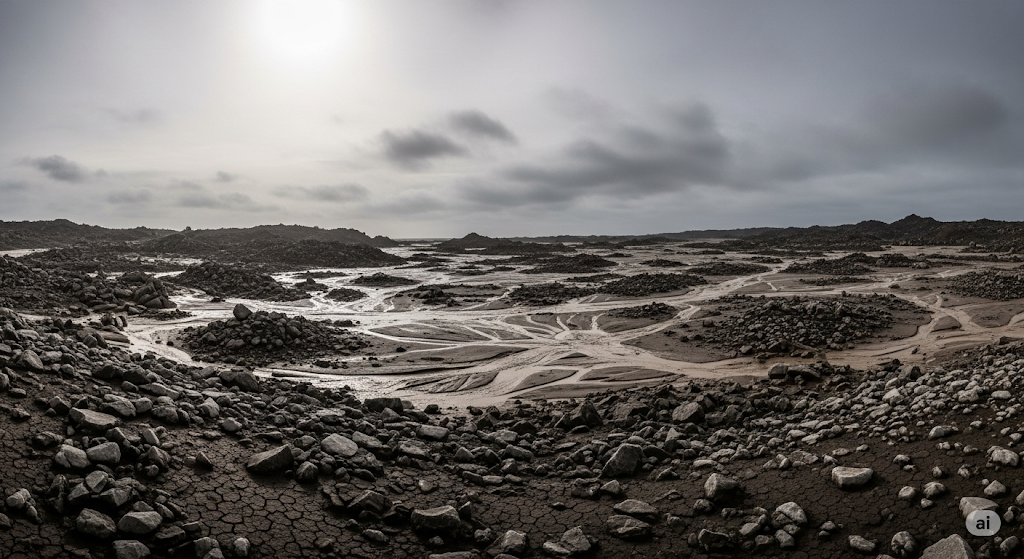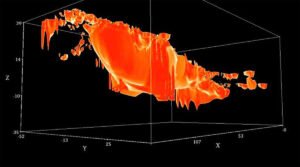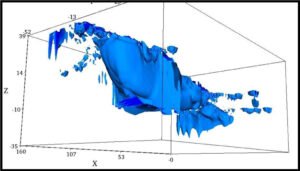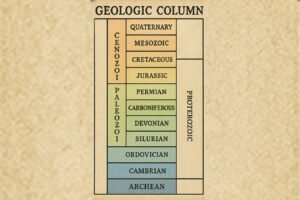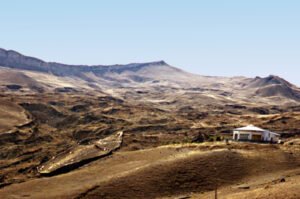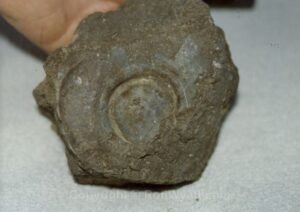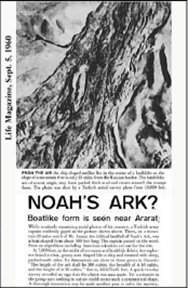The Cataclysm of the Flood
The Geologic Consequences of the Great Flood of Noah’s Time
The description of the flood in Genesis is incredibly short, but it says enough to let us know what a tremendous catastrophe occurred:
GEN 7:11 ...the same day were all the fountains of the great deep broken up, and the windows of heaven were opened.
All the water contained in the earth was "broken up" and the waters above the atmosphere came hurtling down to the earth. If all this doesn't sound particularly violent to you, think again. Before the flood, a tremendous amount of water was suspended above the atmosphere in the "canopy" and also great quantities were in aquifers in the earth. All of this water, most of which is now contained in the oceans, came exploding out and down at the same time, as we read in:
Gen 7:11 In the six hundredth year of Noah's life, in the second month, the seventeenth day of the month, the same day were all the fountains of the great deep broken up, and the windows of heaven were opened.
The force of this cataclysm had to be far greater than any nuclear explosion man could dream of. Then, when it was over with, the entire planet was completely covered in water. All life was extinguished except for those on the ark. The tremendous currents and tidal waves would have had such force that the face of the planet was marred and scarred beyond description. All matter except the bedrock had to have been engulfed in the turmoil.
To better understand, if you take a bottle of water, place soil, pebbles, grass, leaves, etc., in it and then shake it up, you can see on a tiny scale what had to have occurred. But during the flood, it was more than soil, pebbles and grass- it was everything, including animals, men, women and children, homes,- everything on the face of the planet. Nothing would be the same after it was all over.
The Face of the Earth During the Flood
Everything on the earth's surface was in liquid suspension. The only thing remaining stable was the bedrock. And in this "earth soup" were the bodies of thousands, perhaps even millions, of dinosaurs"- some gigantic and some as small as our lizards today.
As the turmoil lessened, the debris in the water began to settle. The heaviest and densest materials (elements) naturally settled to the bottom first. But the turmoil was not consistent over the entire planet so some areas experienced some settling before others did. Also as the waves and currents travelled continually over the face of the earth, new debris would be washed into some areas after initial settling had begun, producing multiple settlement, or "strata".
The Heaviest Elements Deposited at the Greatest Depth
The heaviest matter would have included uranium, the heaviest element. As this was deposited at the greatest depth and more earth and matter settled upon it with great force, the radioactive decay of the uranium, radium and etc., caused tremendous heat at the bottom of the sediments over time. The rocks were melted at these sites. The water coming in contact with this tremendous heat produced incredible amounts of steam.
This volcanic activity caused upheaving of the earth. Great mountain chains were upthrust. Volcanoes spouted lava in great quantities. One effect of this upheaval was that the entire equilibrium of the earth was disturbed. The delicate balance which kept the earth rotating on its axis was interrupted numerous times and the planet shifted its entire bulk, which further thrusted and tore the surface.
The Earth Shifted Its Axis Many Times
Evidence that the earth shifted on its axis numerous times in a very short time period is proven by rocks such as magnetite. During their formation, these rocks developed lines within them which aligned with magnetic north. Magnetite specimens have been found which display as many as 10 or more different alignments, proving that during the time that the rock was cooling, the earth changed its magnetic poles at least 10 times.
And during this tremendous cataclysm, some of the huge bodies of the gigantic "dinosaurs" were buried deep in the earth, along with everything else. Due to their density, many were buried in a deeper layer than the lighter animals, but not always. As the currents and waves continued, more debris was deposited, again settling out according to its weight and density. This resulted in a "layering" effect- or strata.
Finally, we read that the rain stopped.
The Wind Passed over the Earth
GEN 8:1 ...and God made a wind to pass over the earth, and the waters asswaged;...3 And the waters returned from off the earth continually:...
The story of the flood is extremely short, considering the events which occurred. And therefore, we must know that every word in the account is important.
The fact that a "wind" is mentioned as passing over the earth to help dry the waters indicates that this was no little wind. In order for this wind to have any effect on the incredible amount of water on the face of the earth, it would have had to have been greater than any hurricane or tornado we can imagine. It must have been of absolutely incredible force, actually forceful enough to move masses of earth.
See our article on the Ice Age as Ron believed it was a result of this incredible wind.
And as this earth was moved around, some water was able to return back into the earth and some was evaporated. But the majority of water remained in the incredibly deep chasms that now contain the oceans and a tremendous amount was frozen into the glaciers.
And as the water receded into the earth, the fossilization of the animals buried deep in the earth began.
How the Dinosaur Bones became Fossilized
Have you ever wondered why we don't find plants and dead animals in the process of petrifying today? If, like the evolutionists want us to believe, all the fossils are from thousands and millions of years ago, why don't we see things being fossilized today? Think about this because it's very important. If what scientists tell us is true- that all the fossils in the earth's layers are from various geologic times,- why aren't things being fossilized today?
The answer is simple. In order for living things to become petrified, certain circumstances must exist.
Circumstances which cause Petrification or Fossilization
First of all, the object must be buried rapidly in order to prevent deterioration through decay and rot. It must be cut off from oxygen. Today, if an animal dies in the forest or jungle, it soon decays away if it isn't first eaten by other animals. It can't possibly petrify unless it is preserved.
Secondly, there must be continual water flow over and around the buried object. Petrification is the replacement of each molecule of the animal bone (for example) by mineral matter. As the water flows over the object, it washes away a molecule. Immediately a tiny mineral molecule of washed in material plugs the hole left by the washed-away molecule. In this manner, even the cellular structure is sometimes perfectly preserved.
The massive amount of fossils in the earth today could only have been preserved by an incredible amount of water flowing over an incredible amount of rapidly-buried plants and animals. Ask any paleontologist to find you bones being petrified today. It just isn't happening. There may be one or two recent examples, but I guarantee they are as rare as hen's teeth.
Forgeries, Lies and Fantasy
The whole idea of evolution is based on the supposition that there is no God. You read Darwin's own observation about the total absence of transitional forms. Our problem is that we no longer choose to think for ourselves. We have gotten lazy. We sit back and let the "scientist and learned men" tell us what to believe.
The "learned men" who believe that life evolved from chaos and evolved over millions of years say that the similarities in different kinds of animals are the result of their evolving from a common ancestor, when in fact these very similarities are staggering proof of a common Creator.
I felt literally sick the last time we went to the Smithsonian dinosaur display as I overheard parents telling their children how many millions of years ago each dinosaur lived. And then I got angry as I realized what was happening. Those precious children were being taught that the Bible was a lie. That realization hit me like a ton of bricks in my face. I never felt so helpless as I did that day. How can we expect people to have faith in our precious Jesus if they cannot believe the Word of God?
HOW MUCH DO SCIENTISTS REALLY KNOW?
The Piltdown Man Hoax
Have you ever heard of the "Piltdown Man"? Back in 1912, two men announced that they had found the so-called missing link between ape and man. Their evidence was a few pieces from a skull, a piece of a jaw, some teeth and a few other fragments. It wasn't until 1953 that the whole affair was exposed for the elaborate hoax it really was.
The fragments turned out to be parts of a human brain case, a piece of the mandible of some sort of ape, fragments of hippopotamus, deer and beaver teeth, and other fragments of elephant, mastodon and rhinoceros. It's a long story but it’s now common knowledge and well documented that it was a hoax.
And it may seem harmless to you now that it’s been exposed. But did you know that over 500 people obtained their PhD by writing their thesis on "the Piltdown Man"? I dare say, no one took back those PhDs after it was exposed and those people taught hundreds of thousands of people.
Dinosaur Skeletons are Recreated from Just VERY Few Bones
Then there's the dinosaur evidence. I'll bet most of you think that entire skeletons have been found of all the dinosaurs- after all, that's what you see in the museums and in the science books. But that's not exactly the case:
"Many dinosaurs are so poorly known, they have been identified by only a few shed teeth, a tradition fraught with scientific problems. From just a few pointy teeth Troodon formosus...was one of the first dinosaurs named, more than a century ago....But for a century not much more of Troodon than its teeth were known.” (Dinosaurs Rediscovered, by Don Lessem, p. 29.)
Dinosaur Bones Hunters Cope and Marsh Not to be Trusted
You would be very surprised and probably shocked if you knew just how little evidence some of these dinosaurs are based on. You can gain a little insight into some of the problems by reading about the early dinosaur hunters. Two of the most prominent of these were Cope and Marsh who searched for the giant fossils in the 1800's. As two of the original "founding fathers" of this new science, they were vicious competitors.
They found and named no telling how many new species of dinosaurs, but there were just a few problems with their research. For one, they were so fiercely competitive that they would secretly plant bones in each other's dig sites. If this doesn't seem like such a big deal, you must understand that these dinosaur skeletons don't come assembled except in very rare cases and then its only portions of the skeleton that are connected. No, dinosaurs are reconstructed from bones found together in an area. Therefore, there's a very good chance that many of the specimens these men came up with are just not valid.
Here's evidence:
"When in 1877 O.C. Marsh found the type specimen of Brontosaurus, now in the Carnegie Museum, the original lacked the skull. Marsh assumed that the skull was short and round, like that of the similar but smaller Camarasaurus. For a century, incomplete Brontosaurus skeletons and statues and pictures of the animals as they presumably appeared in life...were given these bullet heads. Then, it transpired that Brontosaurus actually had a long, narrow skull like that of Diplodicus. It will take years to correct this error everywhere. (The Day of the Dinosaur, by de Camp and de Camp, p. 121.)
Here's even more evidence that Cope and Marsh really hoodwinked the public with some of their "discoveries":
"The rivalry was heated. Prospectors fought off Indians, fired at each other, hid their finds, and appropriated their rivals' discoveries....Nearly every find was dubbed a new species. Many of the 136 dinosaur species Cope and Marsh named over the next two decades have since been invalidated."(endnote: 12) Or, how about this?-"Another time, Marsh's men, knowing that Cope was spying on them, deliberately mixed the skull of one creature with teeth from another and left them for Cope to find and describe as a new species." (The Day of the Dinosaur, p. 223.)
It should be quite obvious by now that our knowledge of dinosaurs isn't based on the most solid evidence. Most bones are found in jumbled piles with many, many different animals being represented. As we said earlier, nearly complete specimens are extremely rare which leaves us at the complete mercy of the person reconstructing the skeleton.
For example, when Gideon Mantell drew his reconstruction of the skeleton of the Iguanodon, he placed the spike-like object on the nose, similar to the rhinoceros horn. Later, this was proved to be wrong but the misconception persisted for many years. They have since placed this spike as the thumb, but who knows- this could one day change, too.
But this problem of over-active imaginations didn't end with the old dinosaur-hunters. Take the example of Jim Jensen who only retired in 1985:
"But there were other problems with Jensen's naming of his giants. Though based on prepossessing fossils, those fossils are but fragments from a jumbled quarry. And they could only be contrasted with other fragments of already named but still only partially known dinosaurs." (Dinosaurs Rediscovered, p. 174.)
Today, everyone loves dinosaurs. But what we see in the museums and science books are not reality. Years ago, Ron remembers seeing a Life Magazine cover which featured a man holding a fossil tooth and the caption went something like this: "From this single tooth, I can reconstruct an entire dinosaur..."
And that's closer to the truth than scientists would like to admit. When you go to the museum and view a Triceratops skeleton, it's only natural to believe that the skeleton is real, or at least a copy of a real skeleton, right? Think again, as we read this quote about them:
"And they are principally known from their skulls. Unlike the pattern for most dinosaurs, for ceratopsids skulls are relatively abundant, their postcranial remains are rare. Not one complete skeleton of the familiar Triceratops is known." (ibid. p. 277.)
The bottom line is simply this- dinosaurs existed alongside all the other pre-flood animals, most of which were also giants (when they were full grown) compared to the animals of today. But, the fossil bones of the dinosaurs prove that they were animals of the same genus we have today. Many may be species that no longer survive. But, the only real knowledge we have of them is scant.
And they WERE on the ark! Learn more in the next chapter...
Noah's Ark Chapter 12- Were Dinosaurs on the Ark?

Welcome to the Ron Wyatt Archives. I'm Mary Nell (Ron's wife) and this site will attempt to fully document Ron Wyatt's work and discoveries. This website will be an ongoing project to document his work on all his various discoveries. Please check back often as new things will be added constantly.
| READ MORE |

